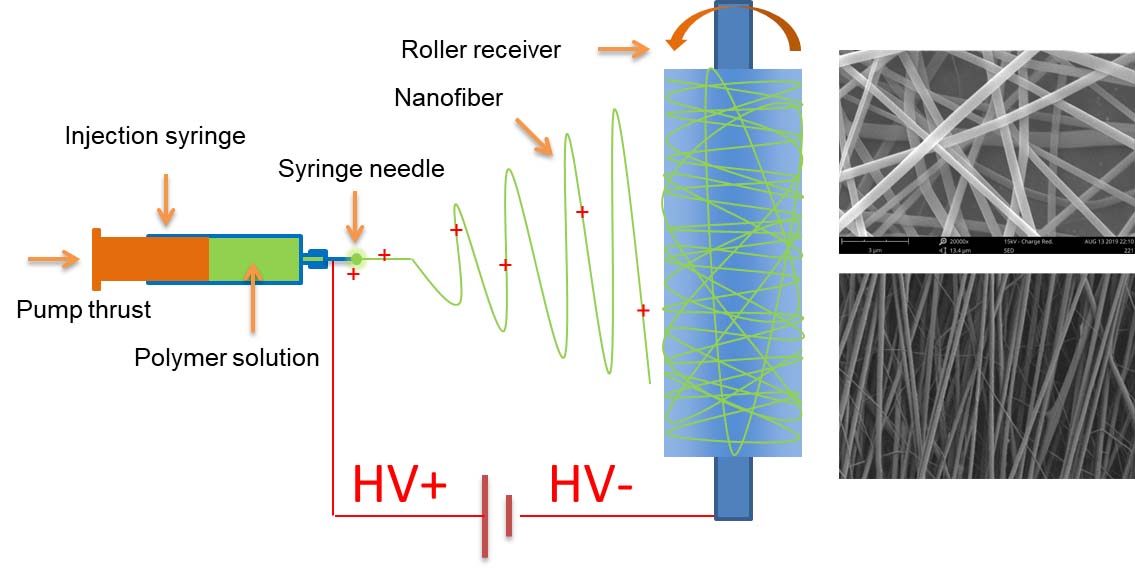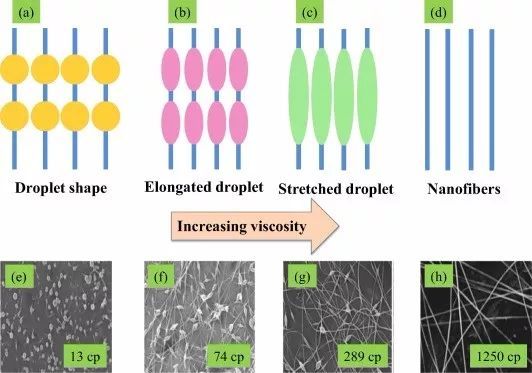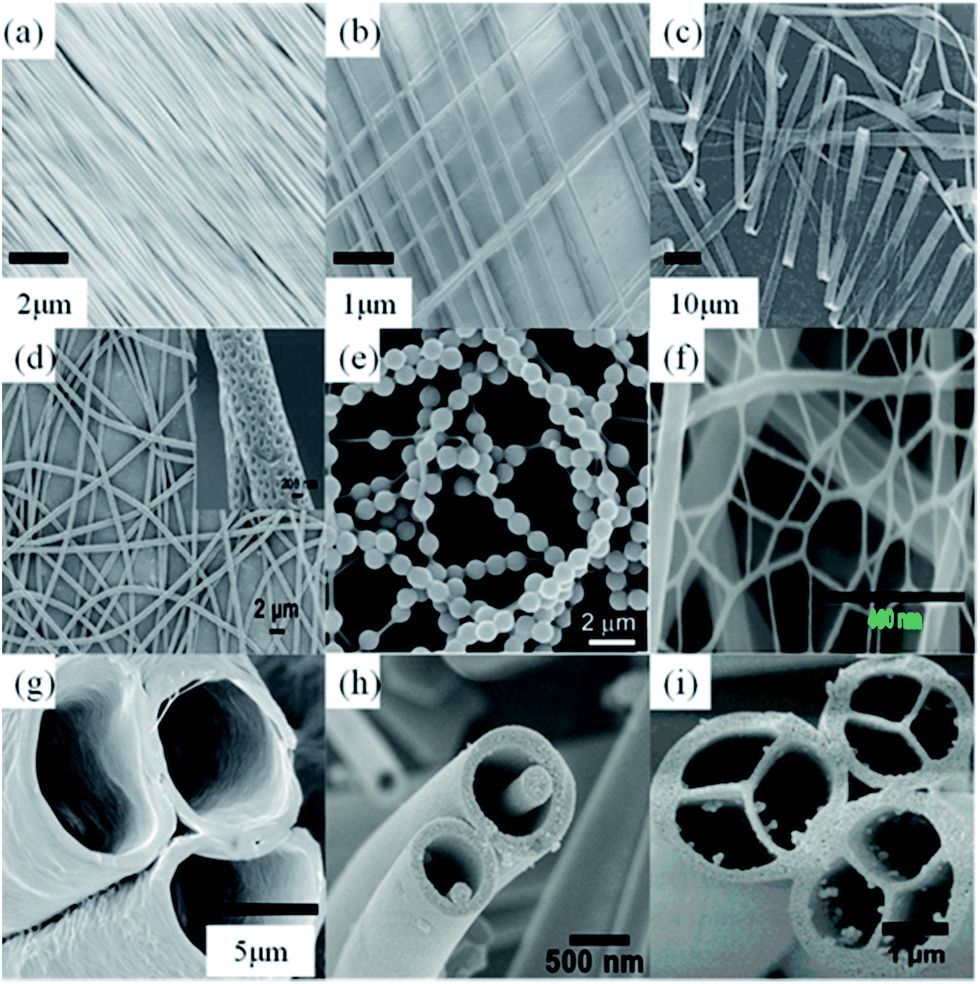Copyright © 2022 Foshan MBRT Nanofiberlabs Technology Co., Ltd All rights reserved.Site Map
1. Typical electrospinning device

Figure 1 Schematic diagram of electrospinning
A typical electrospinning device consists of a liquid supply device, a spinning needle, a high-voltage supply device and a receiving device.
The liquid supply device is mostly a micro syringe pump, which can squeeze the spinning solution from the needle at a constant flow rate to maintain the balance between the liquid supply and the actual spinning efficiency. The usual single needle supply volume is 0.5-2mL/h.
The spinning needle is a flat-mouth stainless steel needle, the commonly used specification is 18G-22G, 1/2-1 inch.
High-voltage supply devices are mostly single-positive high-voltage power supplies or positive-negative dual high-voltage power supplies. Usually the spinning needle is connected to positive high voltage, and the receiving device is grounded or negative high voltage. The usual spinning voltage is +10-25kv, and the receiving negative high voltage is -5-10kv. ; Its role is to form a spinning electrostatic field between the spinning needle and the receiving device, and provide static charge for the needle tip spinning droplets.
The receiving devices are mostly metal flat plates, rollers, rotating discs, etc., among which the fibers received by the rollers have the best uniformity. Both the flat plate and the rotating disc receive the fiber membrane that is thick in the middle and thin around the circumference. High-speed rollers and high-speed rotating discs can be used to prepare oriented nanofiber membranes.
2. Electrospinning principle
Electrospinning technology is a simple and efficient nanofiber preparation technology, its principle is: in the high voltage electrostatic field, when the electric field force is greater than the surface tension, the charged polymer solution or melt droplets will be sprayed into filaments, drawn and refined under the action of electric field force, accompanied by solvent volatilization or melt cooling, and then solidified into nanofibers with a diameter of 50-300nm, which are finally deposited on the receiving device.
3. Influencing factors of electrospinning
(1) Spinning solution factors:
Material molecular weight: There is no fixed standard for how much molecular weight can be spun. Actually choose the molecular weight of the corresponding material in the literature; It is often found in polymers with low molecular weight, and other parameters cannot be adjusted for smooth spinning.
Solvent: Solvent volatility, solubility, surface tension and electrical conductivity all have varying degrees of influence on spinning. Among them, volatility and solubility need to paid more attention. Too strong volatility is easy to lead to needle blockage, too weak volatility is easy to lead to incomplete solvent volatilization, fiber adhesion and dissolution; The specific situation in the experiment can be analyzed.
Spinning solution concentration/viscosity: Spinning solution concentration and viscosity are directly proportional. The general rule is that the viscosity of the spinning solution is too low, the fiber is in a beaded morphology, the viscosity of the spinning solution is too high, the fiber draft is difficult, the fiber continuity is poor, the diameter distribution is wide, and the diameter is thick. There is no uniform standard for the viscosity of the spinning solution of different materials and solvent systems. All the experimental phenomena and general rules are used to comprehensively analyze and adjust the viscosity of the spinning solution to achieve a good spinning effect.

Figure 2 The effect of viscosity on the morphology of electrospun fibers
Surface tension of spinning solution: if the surface tension of spinning solution is too high, it will make it difficult for the electrostatic field force on spinning droplets to break through the surface tension for spinning.
Conductivity of spinning solution: generally, the higher the conductivity of spinning solution, the stronger the charge carrying capacity of spinning jet and the greater the tensile force. Appropriately increasing the conductivity of the spinning solution is helpful to improve the spinning efficiency and refine the fiber; However, the conductivity of the spinning solution is too high, the jet flow is unstable, and even the continuous spinning is impossible.
(2) Environmental factors
Temperature: ambient temperature is a factor affecting the rate of solvent evaporation and humidity. By increasing the spinning ambient temperature, the ambient humidity can be reduced and the solvent volatilization rate can be increased.
Humidity: environmental humidity is another factor affecting the rate of solvent volatilization, high humidity is not conducive to solvent volatilization, resulting in fiber bonding; Under high humidity, some of the materials will have flocculent accumulation of fibers at the receiving device.
(3) Equipment parameters
Receiving distance: affects the degree of solvent volatilization, electric field intensity and fiber refinement.The receiving distance is too short, which will lead to incomplete solvent volatilization in the fiber, fiber adhesion, fiber not effective drafting refinement, fiber diameter is coarse;If the receiving distance is too large, the electric field between the needle and the receiving device will be weakened and the receiving efficiency of the fiber will be reduced.Generally, the receiving distance of electrospinning is between 10-20cm.
Liquid supply rate: Some experiments have found that the fiber diameter will increase with the increase of the liquid supply rate, but the adjustment range is limited. In practice, the balance between the fiber diameter change and the spinning efficiency must be comprehensively considered; the common single needle liquid supply rate is 0.5 -2mL/h.
Spinning voltage: common spinning voltage is +10-25kv, and the receiving device is grounded or connected to negative high voltage for -5-10kv. If the spinning voltage is too small or too large, it is not conducive to spinning; if the spinning voltage is too small, the electric field force is not enough to overcome the surface tension of the solution and form a spinning jet; if the spinning voltage is too high, the jet carries a large amount of charge, and the jet stability may change weak, the drafting time of the fiber in the electric field becomes shorter, and the fiber diameter may become larger. In addition, the spinning voltage is too large, which may easily lead to high-voltage breakdown of the syringe pump and burn out the electronic components of the syringe pump.
Spinning needle specifications: commonly used specifications are 18g-22g, 1 / 2-1 inch. If the diameter of the needle is too thick or too thin, it is not conducive to spinning. If the diameter of the needle is too thick, the electric field of the needle tip will be weakened, and higher voltage will be needed, or even spinning will not be possible; The diameter of the needle is too small, which is not conducive to the maintenance of the needle. At the same time, it will increase the injection resistance of the injection pump, resulting in overload damage of the equipment.
4. Microstructure of common electrospun nanofibers

Figure 3 SEM of nanofibers with various structures
(a) Orientation structure
(b) Cross structure
(c) Banded structure
(d) Porous structure
(e) Beading structure
(f) Nanocobweb structure
(g) Hollow structure
(h) Coaxial structure
(i) Multichannel structure
5. Common electrospinning materials
(1) Water soluble polymer
PEO, PVA, PVP, etc
(2) Water soluble polymer
PVDF, pan, PU, PLA, PCL, PA, PS, PES, PC, CA, PMMA, pet, etc
(3) Biodegradable polymer
PCL, PLA, PLGA, CS, SA, SF, ha, PBAT, etc
(4) Natural polymer
Protein, collagen, hydrogel, sodium alginate, cellulose, chitosan, etc.
6. Common electrospun receiving substrate
Aluminum foil: good conductivity, high receiving efficiency, some materials may be difficult to remove from it.
Release paper: good anti adhesion, easy to remove film; The conductivity is poor and the receiving efficiency is not as good as that of aluminum foil.
Nonwoven fabric, screen cloth: the preparation of filter materials commonly used substrate; The conductivity is poor and the receiving efficiency is not as good as that of aluminum foil.